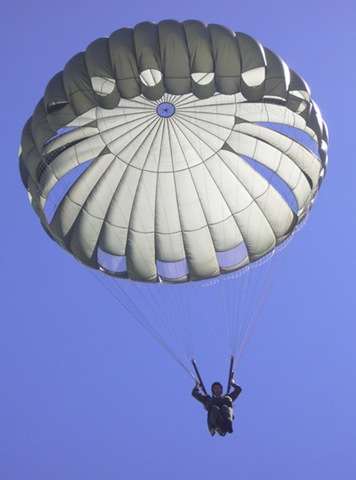I perked up when I saw a story mentioning smokejumpers in the Stars and Stripes, and this is what they were talking about. Strategy Page just posted about it as well. The parachute that they were discussing is called the MC 6, and it has a different name in the smokejumpers. It is called the FS 14 canopy. It is a round (shape of the canopy) chute, and it is great for steep descents into tight jump spots surrounded by tall trees. It is also steerable, and you can get different sizes of chutes, depending on the weight and size of the jumper. I jumped a large when I was using the canopy in the Forest Service, and they are the ones who primarily use this canopy. I think the smallest spot surrounded by trees that I ever jumped with this parachute was the size of a small house. This parachute struggles in higher winds though, and I like a different parachute for that stuff.
When it comes to a great all around parachute for rough terrain parachuting, I preferred the RAM Air DC 7 canopy or square canopy. The MC 5 is the military equivalent. This parachute looks like the sport parachutes you see in the civilian world, and they are very nice.
This parachute is primarily used by the Bureau of Land Management and the Forest Service is slowly transitioning to this parachute. As we speak, they are doing cross training between the two organizations in order to gain proficiency. The BLM uses this parachute for the Great Basin in the western US, and up in Alaska. Both areas have higher winds, and big open areas. But both areas also have their mountains and trees to jump into. Having jumped rounds and squares (parachute types), I would have to go with squares as being the best all around parachute to use for all types of terrain. What I imagine the SF is doing, is just having the option to use either the MC 5 or the MC 6, depending upon the mission. That is smart, but hopefully they are proficient on both, and muscle memory doesn’t screw them up while using one parachute or the other. You definitely have to know each parachute and it’s deployment system very well in order to get a good parachuting strategy for getting on the ground safely and in rough terrain.
As for the T 11, it looks interesting, but I really cannot comment on it. Just as long as it is stable, easy to control, and gets the guys on the ground safely, then I am all for it.
Now what is exciting about the T-11 and the MC-6 is that both of these parachutes will make parachute operations a tad more safer, and make the option of airborne operations in war a little more feasible for future missions. Who knows, maybe the military might take another look at Fire Force type operations as a viable way of attacking enemies? Parachuting troops in places like Afghanistan, might be a safer option than flying in with helicopters or driving in via convoys. Parachuting also distributes the forces more. One missile or one IED can take out a multitude of troops in a helicopter or vehicle. Parachuting soldiers who are only exposed in the air for around 40 plus seconds, can make them very spread out and very hard to shoot.
And because the Taliban are such poor shots, I don’t think they could be very effective at shooting soldiers out of the sky as they parachute to the ground. Especially if there is a sniper team on the ground, or some airship circling around and lighting up any enemy forces that want to take a shot. With good night vision kit, and safer parachutes, night time operations might also be more feasible as well. I am sure airborne troops have thought about all of this stuff for our current wars, and it would be interesting to hear some of their ideas. You just don’t hear a lot about parachuting operations in this war, and it might be worth some further exploration. Especially if the military is going to invest millions of dollars into two new canopies for the troops, as well as cycle thousands of troops through airborne training. By the way, bravo to the guys at Paraflite for making some awesome parachutes. –Matt
—————————————————-

MC 6 parachute.

T 11 parachute.
Special Forces look to smoke jumpers for new parachutes
By Warren Peace
May 4, 2010
STUTTGART, Germany — Soldiers from the 1st Battalion, 10th Special Forces Group recently got a chance to try out the Army’s new MC-6 parachute, which they say will be put to good use when dropping into tight combat zones in Afghanistan.
The MC-6 is more maneuverable than the aging MC-1, which has been used by Special Forces soldiers for years, and the Stuttgart-based soldiers are the first unit in Europe to train with the new chute.
When searching for a new parachute that could drop them into a small landing area, Army Special Forces looked to the smoke jumpers, who are tasked with descending into the heart of Rocky Mountain forest fires, said David Roy, program leader for the MC-6.
“The U.S. forest services have been using this canopy for about 16 years now,” Roy said. “They use it to get into postage-size drop zones in the Rockies as they go to put out fires.”
Plus, the small drop zones and high altitudes of the Rocky Mountains are very similar to the conditions faced by airborne soldiers in Afghanistan, said Maj. Jason Morneault, assistant product manager for Program Manager Clothing and Individual Equipment for the Army.